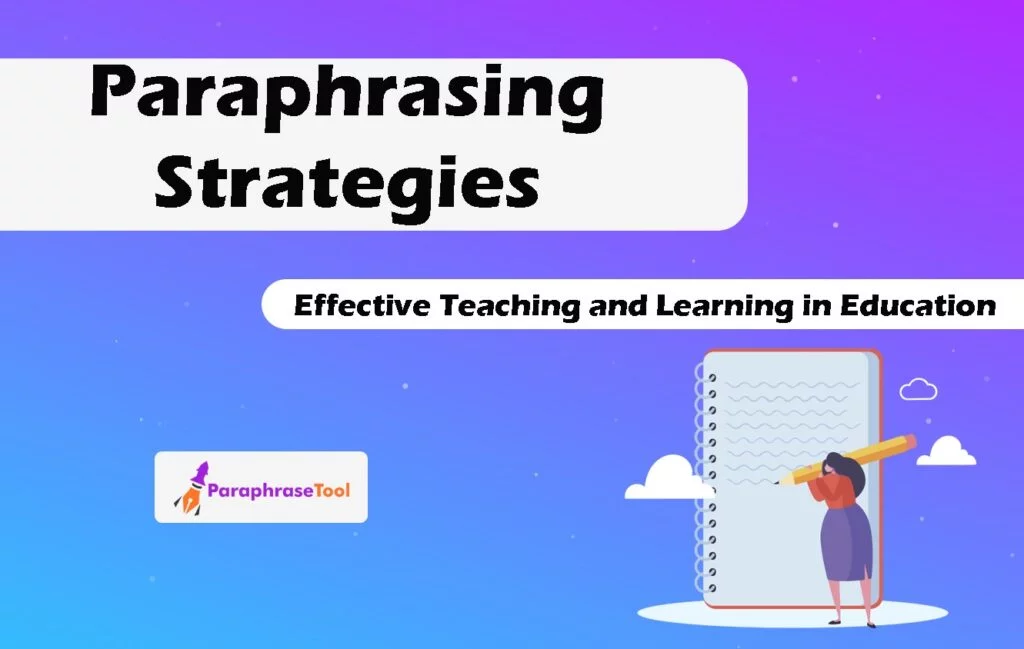Paraphrasing Strategies for Effective Teaching and Learning in Education


Paraphrasing is an essential skill that plays a vital role in both teaching and learning in education. Paraphrasing is the process of taking another person’s ideas or facts and rephrasing them into your own words while keeping the meaning unchanged.
This skill promotes academic integrity and enhances students’ comprehension and critical thinking abilities. In this article, we will explore the significance of paraphrasing, effective strategies for teaching it, and its impact on the overall learning process.
Importance of Paraphrasing in Education
Paraphrasing is more than just swapping a few words around in a sentence. It’s about getting the main idea and expressing it in a new way using different words and sentence structures. This skill is super important for students, as it helps them show respect for others’ work and present information in their own unique style.
However, students should be aware that there is a thin line between paraphrasing and plagiarism. Using someone else’s work without giving them credit for it, often known as plagiarism, is a major ethical breach.
As teachers, we play an important role in teaching our students to change that line ethically, showing them how to paraphrase with the help of a paraphrase tool while still giving proper credit to the original sources.
By helping our students grasp paraphrasing and its ethical significance, we’re boosting their academic skills and encouraging their integrity and respect for others’ ideas.
Paraphrasing Strategies for Teaching
Strategies for teaching paraphrasing to students for a better learning experience and results are:
- Explicit Instruction Techniques
To instill paraphrasing skills effectively, educators can use explicit instruction techniques. Providing clear definitions and examples of paraphrasing can help students grasp the concept better. Engaging students in activities where they identify synonyms and restructure sentences can also strengthen their understanding.
- Contextual Learning Approaches
Contextual learning can enhance the practical application of paraphrasing. Educators can create real-world scenarios for students to practice paraphrasing by using authentic texts in various subjects. Group activities encourage peer learning and collaborative skills, making learning enjoyable.
- Technology Integration for Paraphrasing
Integrating technology into teaching paraphrasing can be engaging for tech-savvy students. Online paraphrasing tools and resources like paraphrasetool.online can help students in practicing the skill independently.
However, it is important to teach them how to evaluate and compare different tools to maintain the quality of their work.
Assessing Paraphrasing Skills

Methods for assessing paraphrasing skills to paraphrase accurately and effectively with the help of a paraphrase tool are:
- Formative Assessment Methods
Incorporating formative assessments, such as in-class exercises and quizzes, allows educators to measure students’ progress regularly.
Additionally, peer and self-assessment techniques can encourage students to be actively involved in their learning process. Providing constructive feedback is important to guide students toward continuous improvement.
- Summative Assessment Strategies
Integrating paraphrasing assessments into writing assignments and research papers can evaluate students’ ability to apply the writing skill in academic contexts. Oral assessments can also be valuable for assessing their paraphrasing skills in verbal communication.
Overcoming Common Challenges
- Identifying and Addressing Plagiarism Issues
Teaching paraphrasing with the help of a online paraphrase tool can help mitigate plagiarism concerns, but educators must be attentive when identifying potential instances of plagiarism. Implementing citation and referencing guidelines can ensure students give credit to the original sources.
- Dealing with Language and Cultural Barriers
Language and cultural differences can pose challenges for students learning to paraphrase. Creating an inclusive environment that adopts diverse perspectives and encourages creativity can help students overcome these barriers.
- Encouraging Original Thought while Paraphrasing
Students might need help balancing paraphrasing and expressing their original ideas. Educators can foster an environment that celebrates creativity and rewards unique perspectives while emphasizing the importance of paraphrasing as a fundamental skill.
Integrating Paraphrasing in Curriculum and Instruction
To integrate a paraphrase tool into the curriculum to practice paraphrasing skills, follow the given instructions:
- Aligning Paraphrasing Skills with Educational Standards
Educational institutions should integrate paraphrasing into their curricula, aligning it with academic standards and learning objectives.
By doing so, paraphrasing becomes an integral part of the educational journey.
- Designing Lesson Plans that Incorporate Paraphrasing
Lesson plans should include activities and exercises that promote paraphrasing skills across various subjects. Incorporating rephrasing into reading and writing assignments strengthens its importance in different contexts.
- Fostering a Paraphrasing-Friendly Classroom Environment
Creating a classroom culture that values paraphrasing and rewards efforts to improve the skill can motivate students to become proficient paraphrasers.
Enhancing Learning through Paraphrasing

By following the given steps, we can enhance learning through paraphrasing.
- Relationship Between Paraphrasing and Comprehension
Mastering paraphrasing can lead to a deeper understanding of the content. Students’ comprehension improves remarkably when they engage with the material at this level.
- Boosting Critical Thinking and Analytical Skills
Paraphrasing requires students to analyze and solve problems actively. Their critical thinking abilities are sharpened as they practice this skill, enabling them to evaluate information more effectively.
- Supporting Students with Diverse Learning Needs
Paraphrasing offers a beneficial way for students with different learning needs to interact with the curriculum. Educators can adapt to individual learning styles by presenting information in different ways.
Case Studies and Best Practices
In successful case studies, educators have observed a positive correlation between effective paraphrasing instruction and improved student academic performance. These studies highlight the importance of a well-structured approach to teaching paraphrasing and its far-reaching impact on students’ overall learning experience.
Conclusion
Paraphrasing is a priceless skill that serves as the cornerstone of effective teaching and learning in education. Through clear instruction, contextual learning, and technological integration, students can master this skill and gain its numerous benefits.
Educators can create an inclusive and supportive environment that encourages students’ paraphrasing abilities with the help of a online paraphrase tool by considering and addressing everyday challenges.
When thoughtfully integrated into the curriculum, paraphrasing can enhance students’ comprehension, critical thinking, and communication skills, empowering them to become successful learners and responsible contributors to the academic community.




